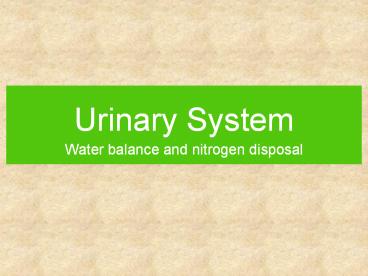Urinary System - PowerPoint PPT Presentation
Title:
Urinary System
Description:
Urinary system anatomy Main structures of ... renal cortex renal medula renal pelvis nephrons Anatomy of the Nephron Glomerulus Proximal tubule Loop of Henle ... – PowerPoint PPT presentation
Number of Views:132
Avg rating:3.0/5.0
Title: Urinary System
1
Urinary System
- Water balance and nitrogen disposal
2
Homeostasis
- The urinary system maintains homeostasis in
several ways - Removal of urea (nitrogenous waste) from the
bloodstream. - Control of water and salt balance in the
bloodstream. - Involved in blood pressure regulation.
3
Blood pressure
4
Renin
- Renin is an enzyme released by the kidneys in
response to a drop in blood pressure. - Renin catalyzes the production of angiotensin, a
hormone that causes arterioles to constrict,
raising blood pressure. This also reduces the
rate of blood filtration causes water retention.
5
Erythropoietin
- A second response to low blood pressure is the
release of erythropoietin, another hormone. - Erythropoietin travels to the bone marrow and
stimulates the production of new blood cells.
6
Urea removal
7
Amino acid metabolism
- Amino acids are the building blocks of protein.
If not needed for building protein, then can be
metabolized for energy, or broken apart and the
carbon chains used to make fat. - Metabolism requires removal of the amine unit
(NH3).
8
Ammonia and Urea
- Ammonia (NH3) is toxic and highly water soluble.
- The liver turns ammonia into urea, which is less
toxic and less soluble.
9
Thinking questions
- Besides toxicity, why is it advantageous for land
animals to convert highly water-soluble ammonia
into less-soluble urea? - What could be a health risk of going on an
extremely high protein diet?
10
Urinary system anatomy
- Main structures of the urinary system
- kidneys
- ureters
- bladder
- urethra
11
Anatomy of the Kidney
- Main structures of the mammalian kidney
- renal cortex
- renal medula
- renal pelvis
- nephrons
12
Anatomy of the Nephron
- Glomerulus
- Proximal tubule
- Loop of Henle
- Distal tubule
13
Glomerulus
- This is the only place in the system where the
blood is actually filtered. - Blood pressure is used to push plasma through
capillary walls and into the Bowmans capsule.
14
Proximal tubule
- Nutrients (salts, vitamins, etc.) are moved out
of the tubule through active transport. - Water follows the nutrients by osmosis.
15
Loop of Henle
- Tissue around the Loop of Henle is salty, from
active transport and diffusion of sodium
chloride. - The salty conditions allow water to diffuse out
of the loop.
16
Distal tubule
- Active transport is used to move more nutrients
out of the concentrated urine. - Some ions, drugs, and toxins are actively pumped
into the tubule.
17
Collecting Duct
- More water leaves the tube by osmosis, since the
tube is surrounded by salty tissue. - Some urea leaves by diffusion, and may be cycled
through the system.
18
(No Transcript)
19
Thinking question
- Notice that sodium is actively recovered in the
system, while potassium may be pumped out. A
natural diet such as hunter-gatherers eat
(mostly fresh plant material supplemented with
lean meat) is low in sodium and high in
potassium. How is this system adaptive when
eating a natural diet? Why does our salty,
low-vegetable American diet cause problems?
20
Water Balance
21
Regulating water balance
- Antidiuretic hormone (ADH, also called
vasopressin) is part of a negative feedback
system that regulates water balance. - ADH increases the permeability of the distal
tubule, allowing greater water recovery.
22
(No Transcript)
23
Thinking question
- Caffeine and alcohol are diuretics. Alcohol
inhibits ADH release, while caffeine interferes
with its activity. Part of the symptoms of a
hangover are due to dehydration. What causes the
dehydration? And why is a cup of coffee not a
good cure for a hangover?
24
Thinking question
- Many over-the-counter herbal diet aids claim to
detoxify the body or flush fat. Many of these
contain dandelion leaves, parsley, or other herbs
known to be diuretics. If a person tries these
products and appears to lose pounds, what is
actually lost? Could there be health problems
with using these products?
25
Final thinking question
- Ords kangaroo rat (Dipodomys ordii) is adapted
to desert life. It survives on very little water.
List some ways in which its kidneys might be
different from the human kidney to allow it to
conserve as much water as possible.































